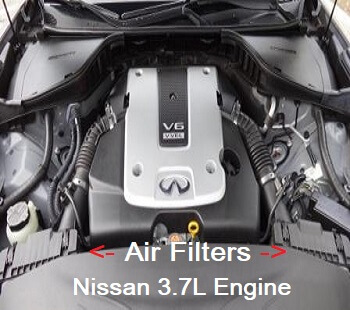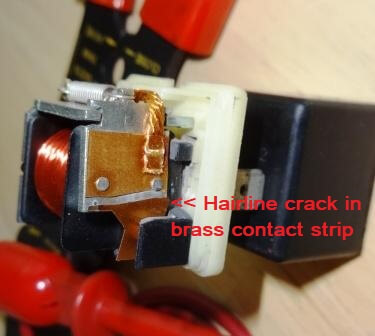DIY Automotive Maintenance
People often make blanket statements about DIY automotive maintenance and car repairs. Generalized comments like cars are too complicated to fix yourself remain a common attitude on the subject.
Here's my standard rebuttal to a blanket statement like that. It depends on what's wrong with the automobile.
This is exactly what this article covers. Before you make the determination of whether you can fix your own car, you need to figure out what's wrong with it and how complicated the repair is.
As far as DIY automotive maintenance goes, oil changes and air filter installations aren't more difficult today than they were on automobiles years ago.
With that said, there are automobiles where it's harder to change the oil or air filter. On the flip side, there's even more automobiles that make it easier to perform these common services.
 Nissan Engine Air Filter Diagram
Nissan Engine Air Filter DiagramFind Out More about the Automotive Problem
Let me give you a textbook example of a DIY car repair you should do yourself. On this website we talk about a lot of horrible air conditioning problems plaguing older automobiles.
However, there's a possible root cause of the malfunction that's so easy to fix, you'll kick yourself if you don't do it yourself.
I'm seeing an increase failure rate of car air conditioning relays. These made in China parts become common failures on specific models.
You can learn more about that specific issue from the previous link. The lesson to learn here is doing some research and finding out the common causes of your automotive complaint.
In the provided example, locating and replacing the relay remains within the skill level of almost every adult human.
However, using the same example, might also lead you in the opposite direction. This becomes a situation where professional diagnosis becomes absolutely necessary. The chances of a complex air-conditioning problem remain as likely as a failed relay.
 Defective Car AC Relay
Defective Car AC RelayLearn about Your Cars Automotive Maintenance
I'm here to tell you that DIY automotive maintenance is not dead. However, you will need to uncover the procedures necessary on your particular automobile before deciding what you can handle.
Let me run through common maintenance items on my own vehicle as an example. I purchased a used Infiniti Q-series four-door sedan. To my surprise, the oil change is difficult for this vehicle.
The factory decided to use a belly pan to protect the undercarriage. They also decided not to provide an access hatch to gain access to the drain plug and filter. This means you remove 20 screws to drop the belly pan.
It makes the job out of reach for some that would prefer to solve their own car maintenance problems. Nevertheless, on all the Infiniti cars with a 3.7 L V-6 engine changing the air filter is as easy as putting on your sneakers. The access hatch for the twin air filter setup is front and center when you pop the hood.
A slide clip holds down the access door to the filter. If you paid someone to replace these air filters you should kick yourself. You can do it yourself and save big by buying aftermarket air filters for the 3.7 L Nissan engine. As another example of regular DIY automotive maintenance on my own vehicle let's talk about the cabin filter.
The dealership service department quoted me a price of $140 to replace the pollen filter. Infiniti located the element behind the glovebox. At first it looked difficult to gain access. However, replacing Nissan pollen filters located behind the glove compartment is a breeze. Why pay $125 more than you need to?
Complicated DIY Car Repairs Simplified
Sometimes it looks like you have a highly technical car problem, but it turns out to have a simple solution. In this section we talk about car computer and sensor problems.
Specifically, we're focusing on, check engine light problems that lead to simple repairs. A lot of people take the vehicle in or continue driving when the amber warning light comes on.
The check engine light is your friend. Not only does it come on to tell you there's a problem, but it also points in the direction of the specific issue.
Grabbing yourself a cheap automotive scan tool and finding out what code set, is a plug and play operation.
After you find out what code the computer set in memory you can do a standard search with the trouble code number and your year, make and model car.
You'll be blown away by the results. In fact, you will find hundreds, maybe even thousands of people experiencing the same exact issue.
More importantly, these people will post what they did to diagnose and fix the problem. You can then drill down deeper to find out whether these repairs fall within your skill level.
Moving your search over to YouTube will often uncover videos of people doing the exact same DIY car repairs in their driveway.
Some inherent issues like a cam sensor solenoid on a Chevrolet Cobalt are drop-dead simple to fix yourself.
Using this example, we’re talking about removing a 10 mm bolt and unplugging an electrical connector. This type of DIY automotive maintenance remains within the skill level of millions of car owners.
Final Thoughts about DIY Automotive Maintenance
Working on cars manufactured during the last 25 years becomes a mixed bag. Performing engine repairs became a lot more complicated with the deployment of many automotive technologies.
I wouldn't want to replace the timing chain set on a 3.6 L General Motors engine as an example. Twenty years ago, they used one timing chain.
Now they use three individual chains that drive four camshafts. This is a complicated repair operation requiring some special auto repair tools and experience.
With that said, we can use the same technology to find things that we can do ourselves. Therefore, in my opinion, take the time to investigate common failures on your specific automobile and what it takes to resolve these issues.
In many cases you'll find DIY automotive maintenance and car repairs you'll enjoy doing. Here's an example of some simple DIY car repairs that helps you extend the life of an automobile. Visit the Fix My Old Ride Homepage for more information.
Author bio : Mark is a retired ASE certified master technician, Chevrolet Professional Service Council member and the founder of FixMyOldRide.com. Watch the video on the about Mark the mechanic page to see his credentials. Mark hand writes all of the articles on FixMyOldRide.com unless indicated otherwise.